Patients with this kind of skin lesions are alertly alert!
Author:Medical community Time:2022.09.23
*For medical professionals for reading reference

Monkey acne epidemic spread? How should we deal with it.
New crown pneumonia has not yet disappeared. Recently, the international monkey acne epidemic has attracted much attention. Even Chongqing was diagnosed with a case of acne at an input case on September 16. After research and judgment by experts, there was no social event trajectory in this case. Low risk.

Figure 1: Derived from Weibo
Globally, due to the continuous increase in the number of monkey acne cases, the mortality rate reached 3%to 6%. The World Health Organization (WHO) announced on July 23, 2022 that monkey acne was an emergency of public health.
As of September 17, 2022, there were 61282 cases of acne diagnosis in the world, of which 60,703 were places where monkey acne was not reported in history (Figure 1).

Figure 2: WHO: Global Map of Monkey Acne Erotic in 2022 [1]
Here, we share the confirmation process of the New York Monkey Case, so that everyone can intuitively understand the details of monkey acne treatment to prepare from time to time.
Profile
The patient was a 31 -year -old man who returned to New York from Miami Holiday to New York.
Two days later, he had scattered blisters in his body. Due to worrying about the condition, he will seek medical treatment locally.
Local doctors collected the skin specimen for a polymerase chain reaction (PCR) test with the local doctor. Before the results come out, no special treatment is done. Therefore, he continued to engage in daily activities, including work and participation in large -scale social activities.
After another 4 days, the above -mentioned skin lesions had not shown signs of retreat, so they went to the dermatologist again.
At this time, the dermatologist asked for a medical history. The patient was healthy before he prosecuted, and there was no special medical history and surgical history. In addition, he prosecuted himself as homosexual, but did not disclose the details of sexual history.
During the consultation, the patient's life signs were stable and did not fever anymore.
Physical examination shows that patients have about 20 pink umbilical pimples with a diameter of 2mm to 8mm in the same period during the same period, surrounded by erythema. These pimples are scattered throughout the body, including facial, trunk, arms and legs (Figure 3).
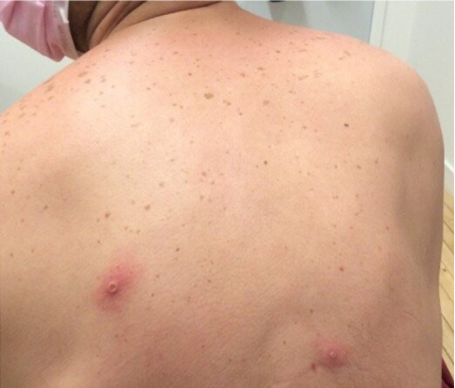
Figure 3. The trunk skin lesions: pink umbilical concave pimples with the surrounding erythema, the diameter of the pimple is 2mm ~ 8 mm [2]
In addition, there are pink, deep in sexual blisters on the soles and feet, accompanied by erosion, about 5mm ~ 6mm in diameter (Figure 4). In addition, the bilateral groin lymph nodes are enlarged, and the oral or genital mucosa has not seen abnormal changes.
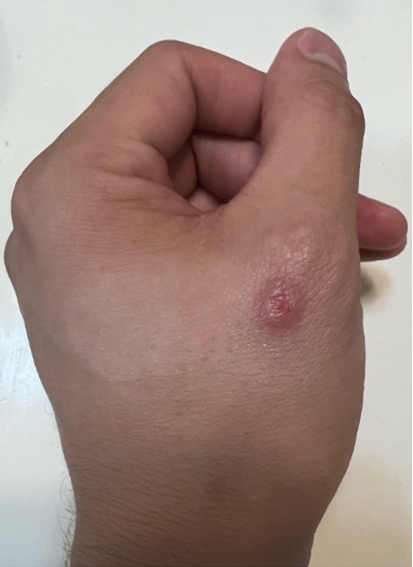
Figure 4. Hand skin lesions: pink deep in sexual blisters with erosion, 5mm ~ 6mm in diameter [2]
Considering the recent history of living in patients, skin lesions are blisters and pimples, and dermatologists wear N95 masks and gloves during the examination.
At that time, the preliminary diagnosis included monkey acne, pure herpes, chickenpox and syphilis.
The doctor made further analysis- ——
(1) The skin lesions of pure herpes and chickenpox are generally smaller, and the distribution range is also smaller, especially for herpes herpes, which is often limited to a single anatomical area;
(2) In addition, the details of the skin lesions, wide distribution, urgency, and pain of pain in comprehensive patients do not support typical first or second phase syphilis;
(3) On the contrary, patients' recent living history and clinical manifestations are more in line with the standards of "suspected monkey acne" in the American Disease Control and Prevention Center (CDC).
Therefore, the doctor immediately reported to the CDC Emergency Action Center and the New York Municipal Ministry of Health.
Subsequently, the patient was sent to isolation for more than 3 weeks to prevent further spread.
Subsequently conducted tissue pathological examinations of patients, showing that the epidermal bureau stove -level necrosis and multi -core horny formation cells were seen (Figure 5).
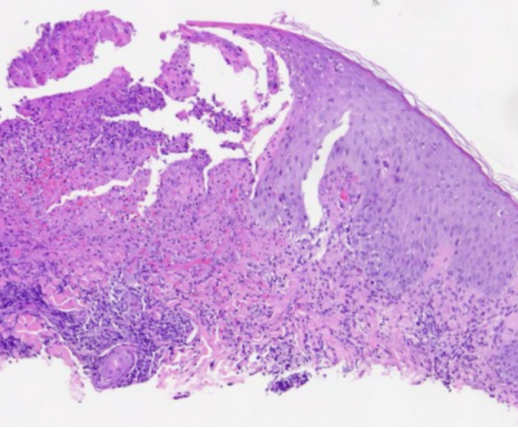
Figure 5. The trunk skin lesions: The epidermal bureau's stove -based whole layer of necrosis and multi -core horny formation cell (HE staining, × 20) [2]
The dense inflammation is visible in the dermis and extends to the epidermis, mainly composed of lymphocytes, neutral granulocytes and red blood cells (Figure 6).
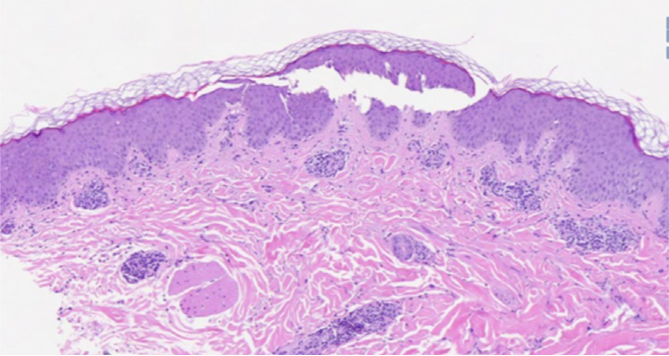
Figure 6. The trunk skin lesions: The dense inflammation in the dermis infiltrates and extends to the epidermis, mainly composed of lymphocytes, neutral granulocytes and red blood cells (HE staining, × 20) [2]
The above manifestations conform to the pathological changes of virus infection.
Two skin lesions samples were collected again with a dedicated swab again, and PCR testing was performed on the spot. The results were confirmed that there was a monkey acne DNA.
As a result, the patient was diagnosed with a monkey acne.
Within the next two weeks, the patient's fatigue symptoms and skin lesions relieve themselves, and the pigmentation is depressed after inflammation.
Pathogenesis
▌1. Main communication method
Monkey acne virus can be transmitted through respiratory tract droplets, close/intimate contact and liquid transmission, which includes non -sexual contact and sexual contact transmission, and even indirect contact such as common items.
WHO summarizes the main communication method in the popular science article for the public:
(1) Skin to the skin, such as touch, sexual life;
(2) Face -to -face, such as face -to -face speaking, singing or breathing;
(3) Mouth to the skin, such as oral sex;
(4) Oral counterpart, such as kiss;
(5) For people, such as contact with bedding, towels, clothing, or other pollutants.
It is particularly explained that because many episodes have a lot to do with male behavior, even more popular in such communities. Doctors call for urgent to formulate appropriate public health measures to improve the status quo.
诊2. Clinical diagnosis
The dermatologist of this example is very successful. They pointed out that according to the CDC standard, when the patients have one of the following two cases, they must doubt the possibility of monkey acne:
Situation 1: The characteristic performance occurs, that is, the skin lesions that are deep in nature and the boundary, the umbilical concave in the center, and the progress of the progress of the skin lesions follows the order of "rash-pimples-blisters-pustules-crust" sequence. Essence Case 2: Clinical suspected monkey acne, and patients meet one of the following epidemiological standards within 21 days after the symptoms appear:
(1) Persons who have acne in social networks have close or even intimate contact, such as gay sexual relationships with others;
(2) Place of countries or places where monkey acne is populated in the diagnostic case of monkey acne;
(3) In contact with people with rash or people who may suffer from acne;
(4) In contact with Africa's unique animals (no matter life and death), especially rodent animals or squirrels.
Understanding the above CDC standards can help detect monkey acne in the early stage, and can conduct dermatologists with purpose and more safely.
经3.
In addition, with these knowledge, dermatologists can quickly be vigilant with suspicious rashes and provide patients with isolation guidance to prevent further spread.
In the end, the doctor also summarized a few experience and disposal experience of suspected monkey acne cases for your reference:
(1) For patients with blisters/pustules/pimples who have a recent history of living and acute attacks, or male patients with sexual contact with other men, they should be highly suspected of monkey acne;
(2) Dermatologists who are in contact with the case of suspected monkey acne infection should wear protective clothing, gloves and goggles (masks), and use N95 or higher -level masks;
(3) Patients should be isolated in a single room, and at the same time wearing personal protective equipment;
(4) The patient's sample should be placed in aseptic plastic container, and the labels are clearly pasted, and the analysis is immediately carried;
(5) The dermatologist should follow the disposal process. If the monkey acne virus is suspected, it should be reported immediately.
Summarize:
The above is the case of Monkey acne published on Jaad Case REP recently published in Jaad Case RAO, the dermatology of the dermatologist at Will Cornell Medical College of New York.
Looking at the full report, it is not difficult to find that as long as the disease is correct, monkey acne can be prevented and cured, and dermatologists play an important role in it.
references:
[1] CDC. 2022 Monkeypox Outbreak Global Map.
https://www.cdc.gov/poxvirus/monkeypox/response/2022/world-map.html
[2] Khan S, Razi S, Rao B. It's Here, Monkeypox: a Case Report. Jaad case rep. 2022; 28: 61-63.
[3] WHO. Monkeypox: What you need to know.
https://www.who.int/multi-Media/details/monkeypox-What-det-Need-know
[4] CDC. Monkeypox. Centers for Disease Control and prevention.
https://www.cdc.gov/poxvirus/monkeypox/index.html
Source: Skin Channel in the Medical Circle
School pair: Zang Hengjia
Responsible editor: Zheng Huaju
*The medical community strives to make any promises and guarantees for the accuracy and reliability of the contents of the content when passing the review, but does not assume the timelyness and integrity of the quotable information (if.)Any responsibility caused by the outdated content and the may not be accurate or incomplete of the cited information.Relevant parties are requested to check or use this as a basis for decision -making.



- END -
Announcement on extending temporary static management measures in key urban areas of Urumqi
Since the implementation of static management measures on August 10, the general public has fully understood, actively cooperated, and participated in the prevention and control of the epidemic. The r
[Fourth Sinoscience Master Medical Road Inheritance] Han Ming's thought of treating lungs
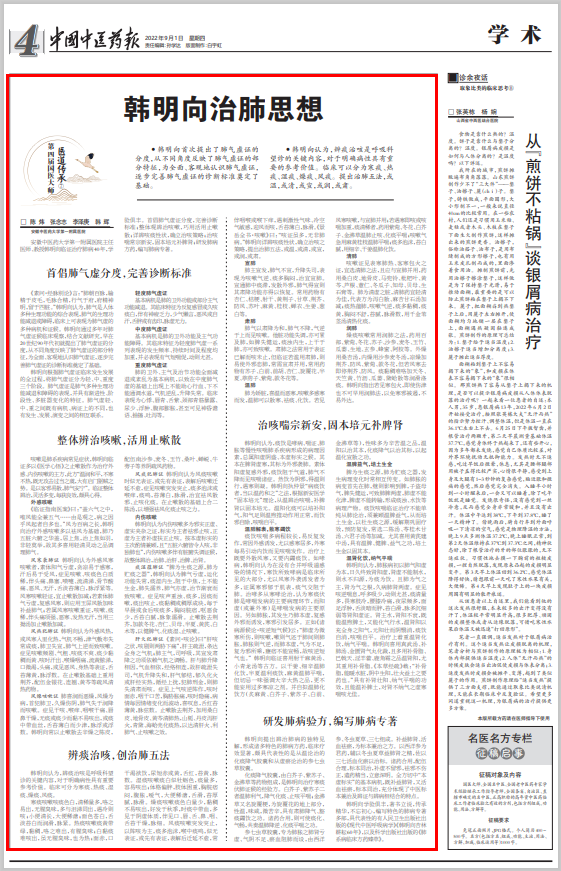
Content source: Chinese Chinese Medicine Reporter: Chen Wei, Zhang Nianzhi Li Zeng...